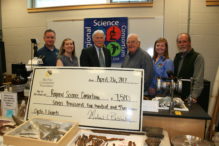

Lake Erie Showcased as Resource by the Regional Science Consortium
August 10, 2017

Dressed in wet suits and equipped with measuring tools, divers are securing their oxygen masks and plunging into Lake Erie on a mission this summer. A team of divers is pushing aside algae blooms and navigating around blankets of zebra mussels to document shipwrecks long ago swallowed in the watery depths.
The Regional Science Consortium is located in the Tom Ridge Environmental Center and its mission is to promote and enhance knowledge and understanding of Lake Erie. In the first quarter of 2017, The Erie Community Foundation made a grant to The Regional Science Consortium to enhance programs that support the efforts of the Pennsylvania Archaeological Shipwreck and Survey Team. This team works to survey, assess and document shipwrecks in the Pennsylvania waters of Lake Erie. Through this grant, the group will document two new shipwrecks, expand its dive team and update the website to incorporate 3D models of sunken artifacts.
Ripples are being made in the world of shipwreck documentation and momentum is full speed ahead sailing into this long term project. “Research and education programming funded by this grant is strategically focused on topics that matter here locally,” said Jeanette Schnars, Executive Director of the Regional Science Consortium. “We are excited to be a part of the beginning of a complex process and would not have been able to accomplish the goals we have set out to this summer without this funding.”
Information recovered from these dives will be on display at the Tom Ridge Environmental Center from November 2017 through April 2018. The feature of this exhibit will be a simulated shipwreck site; visitors will be encouraged to take measurements of artifacts covered in sand and survey the grid to experience what it is like to be one of the divers who document Lake Erie shipwrecks. “The divers bring the shipwrecks to a place where everybody can experience them,” said Schnars. “Through exhibits like this, we are able to bring so much new knowledge to the non-diving community.”